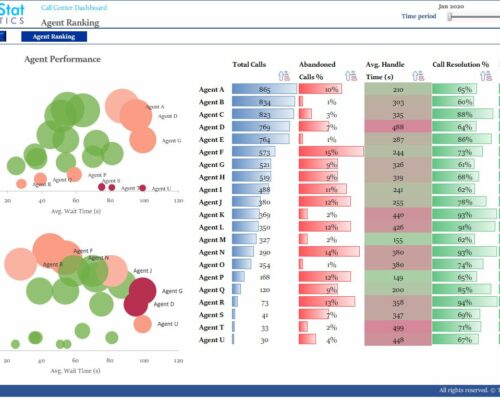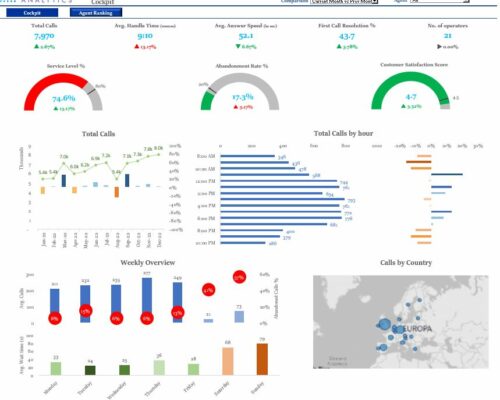Screenshots of the dashboard (without client data) are shown below:


Problem Statement:
In an increasingly customer-centric business environment, the performance of a call center is crucial in shaping the overall customer experience. As such, a reputable call center decided to improve its monitoring and management process by developing an interactive dashboard. The purpose was to achieve greater visibility into key performance indicators (KPIs) and agent performance metrics, facilitating better decision-making.
Solution Overview:
Our team designed and delivered an interactive compliance dashboard comprising multiple tabs, each offering valuable insights and visualizations to address the client’s compliance needs.
Cockpit Tab: This tab provides an overview of the most important KPIs for call center operations. Metrics such as Total Calls, Average Handle Time, Average Answer Speed, First Call Resolution %, Service Level %, Abandonment Rate %, and Customer Satisfaction Score were prominently featured. Not only did the tab display real-time data, but it also provided the percentage change from the previous period, allowing managers to track and compare performance over time. The tab included dynamic charts to demonstrate call trends by month, hour, and week, and a heat map visualizing the number of calls by country. These tools provided the management with immediate insights into call volumes and patterns.
Agent Ranking Tab: This tab was designed to focus on individual agent performance. It allows for agent ranking based on Total Calls, Abandoned Calls %, Average Handle Time, Call Resolution %, and Satisfaction Score.
Benefits Delivered:
The new dashboard provided a significant impact on call center operations and performance:
Enhanced Decision Making: By offering real-time data and trend analysis, the dashboard provided a clear understanding of current performance and future needs, enabling proactive decision-making.
Improved Agent Productivity: The Agent Ranking tab helped identify high and low performers. This facilitated targeted coaching and training, improving overall productivity and quality of service.
Increased Customer Satisfaction: With the improved visibility into metrics like Average Answer Speed, First Call Resolution %, and Customer Satisfaction Score, the center was able to strategize and take action to increase customer satisfaction levels.
Insights Into Call Patterns: The heat map and trend charts helped to identify peak hours, busy days, and high-volume countries. This enabled better staffing and resource allocation.
Conclusion:
The introduction of the interactive dashboard represented a significant advancement for the call center. By allowing management to monitor and compare KPIs in real-time and facilitating better analysis of agent performance, the dashboard played a crucial role in improving the overall efficiency and customer satisfaction. This case study illustrates the power of data visualization and analytics in driving operational excellence in a call center environment.

